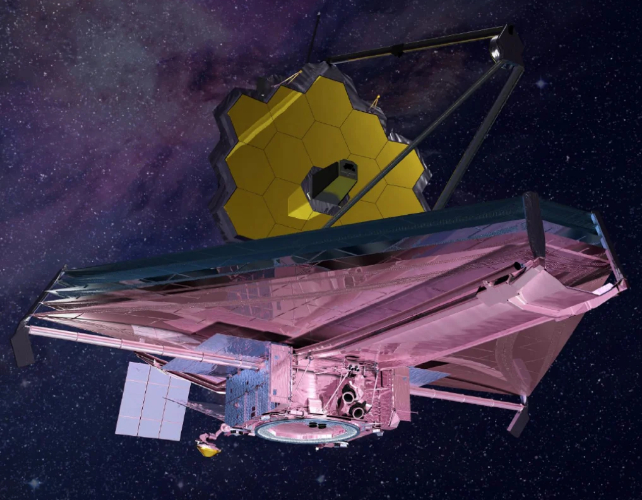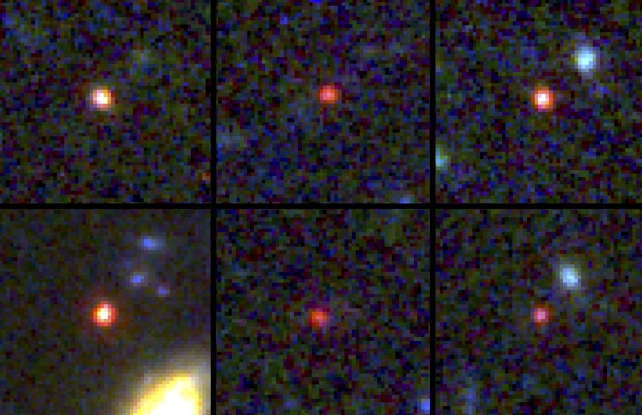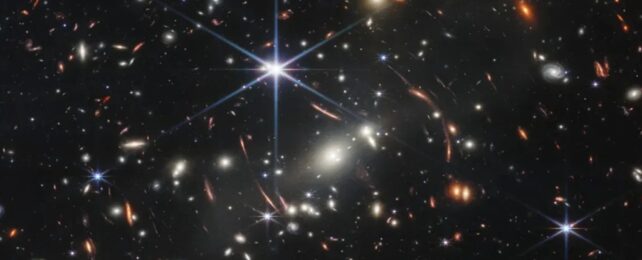Since the James Webb Space Telescope (JWST) began science operations, astronomers have observed galaxies that existed more than 13 billion years ago. It was during this period, known as the "Cosmic Dark Ages," that the first stars and galaxies formed between 200 million and 1 billion years after the Big Bang.
Unfortunately, light from this period was restricted to the relic radiation caused by the Big Bang – the Cosmic Microwave Background (CMB) – and photons released by the reionization of neutral hydrogen by stellar radiation.
Previous observatories, such as the venerable Hubble and Spitzer space telescopes, were unable to observe galaxies during this period because of their limited infrared (IR) sensitivity. But thanks to Webb's advanced IR instruments, coronographs, and heat shield, the curtain is finally being pulled on the Dark Ages.

In a recent study, an international team of scientists searched Webb's archival data from galaxies that existed just a few hundred million years after the Big Bang, pushing Webb to the very limits of its imagining capabilities.
The study was led by Marco Castellano, a researcher from the National Institute of Astrophysics' Obsservatorio Astronomico di Roma (INAF-OAR). He was joined by colleagues from the INAF, the National Optical-Infrared Astronomy Research Laboratory (NOIRLab), the Instituto de Astrofísica de Andalucía (IAA-CSIC), the Harvard & Smithsonian Center for Astrophysics (CfA), the Space Telescope Science Institute (STScI), NASA Goddard Space Flight Center, and multiple universities and institutes.
Since Webb first became operational, it has been observing galaxies that existed more than 13 billion years ago. Images of some of these early galaxies were included in the Webb Early Release Observations (EROs), which featured "Little Red Dots" that turned out to be early Active Galactic Nuclei (aka. quasars).

Prior to Webb, astronomers were able to resolve galaxies that existed up to a redshift of ~10 (~500 million years after the Big Bang) using Hubble and Spitzer, though with much lower sensitivity.
But as Castellano told Universe Today via email, Webb's greater sensitivity has opened a new window on the first phases of galaxy formation and evolution:
"JWST has discovered dozens of sources at higher redshifts up to z-14.2 (the current record holder, corresponding to ~300 Myr after the BB). JWST has enabled a detailed study of their physical properties, including the chemical composition of their gas.
"Among a landslide of exciting results, I would say that two results obtained by JWST need to be highlighted: the high abundance of bright galaxies 500-300 Myr after the BB and the large number of faint AGN in the first billion years."
The number of galaxies found during this period and their apparent brightness surprised astronomers since they were in "tension" with established cosmological models.
The same is true when it comes to supermassive black holes (SMBHs) observed during this period, which were larger than cosmological models predicted.
In both cases, these models suggest that there was not enough time since the Big Bang for so many bright galaxies to form or for SMBHs to become so large.
The former finding, said Castellano, is the focus of his research:
"Since the first observations JWST has found a number of galaxies at z>9 with bright UV emission which is much higher than predicted by theoretical models or on the basis of previous observations.
"In the past 3 years several theoretical attempts have been made to explain this "excess" of bright galaxies either as due to, e.g. very low dust attenutation, or a high star-formation efficiency, or the contribution of emission by metal-poor stars or accretion onto super-massive black holes, etc.
"It is fundamental to search for galaxies at redshifts higher than those explored so far to test the predictions of these theoretical models."
Per their study, the team consulted JWST and HST photometric measurements from the ASTRODEEP-JWST catalogs and analyzed the seven surveys that comprise it.
This included the Cosmic Evolution Early Release Science Survey (CEERS), fields observed by the Great Observatories Origins Deep Survey-North (GOODS-N) and GOODS-South surveys, First Reionization Epoch Spectroscopically Complete Observations (FRESCO), the Next Generation Deep Extragalactic Exploratory Public (NGDEEP) campaign, CANDELS, GLASS-JWST, and more.
As noted, the team searched these photometric data sources for galaxies with redshift values of z = 15-30. The candidates they selected were chosen based on the shape of their spectral-energy distribution and Lyman breaks.
This latter technique involves observing high-redshift galaxies through near-infrared and ultraviolet (UV) filters since radiation from these galaxies is almost completely absorbed by the neutral gas surrounding them.
As Castellano explained, this presented many challenges:
"On the one hand, objects become fainter and are detected in a smaller number of photometric bands, making the constraints on the shape of their spectrum less significant. On the other hand, it is becoming evident that there is a higher risk of contamination from galaxies at lower redshifts. Sample contamination is always an issue when looking for rare distant galaxies using photometric information, but for z>15 samples this problem is worsened by new classes of poorly characterized low/intermediate-redshift objects entering the selection criteria.
"These are typically objects whose spectral-energy distribution mimick that of z>15 galaxies because they are very 'red,' i.e. their emission steeply increases at wavelengths longer than 2 microns because their stellar light is extremely attenutated by dust, or because they are dominated by old stellar populations. In some known cases their photometric points are identical to those of z>15 galaxies because of a combination of a red continuum emission with extremely strong emission lines boosting the flux in some of the observed filters."
At present, astronomers have been able to identify only a few candidate galaxies at redshift values of z = 15 or higher. This is despite the fact that the UV rest frame emission of these galaxies is within the spectral coverage of Webb's Near-Infrared Camera (NIRCam).
Nevertheless, breaking the z = 15 barrier is essential to learning about galaxy evolution during the early Universe when the first stars and galaxies formed. This information will help resolve the current tensions between theoretical models and observations.
Overall, the team selected 10 objects from the ASTRODEEP-JWST catalogs whose colors were compatible with a redshift of z = 15 to 20. However, as Castellano explained, analysis of these sources proved once again that studying objects at these redshifts is extremely challenging.
"[I]t is true that they are credible high-redshift candidates, but they are also compatible with the expected colors of rare galaxy populations at lower redshifts," he said. "In particular, as mentioned above, they could be, instead, dusty galaxies with strong emission lines or old, passively evolving galaxies."
For instance, one of these candidates had already been observed with Webb's Near-Infrared Spectrometer (NIRSpec) as part of the CANDELS-Area Prism Epoch of Reionization Survey (CAPERS).
This galaxy has a high rate of star formation and a redshift of z = 6.56 (~13.2 billion years) but is highly attenuated by dust, making it appear redder. However, the remaining candidates in their study remain potential z~15-20 candidates worthy of further study:
[I]f we assume that they are all galaxies at z>15, the implications are extremely interesting. Their number would imply an abundance of bright galaxies 2-300 Myr after the Big Bang, which is higher than predicted by theoretical models. In fact, the spectroscopic confirmation of even only a small fraction of these objects would imply a significant tension with theoretical predictions."
What's more, the team's study could have implications for the study of dusty galaxies that existed just over 13 billion years ago. Like extremely high-redshift galaxies, galaxies at z = 4 to 7 (12.5 to 13.3 billion years) are poorly understood.
These consist of both low-mass dusty star-forming and low-mass passive galaxies, which are rare compared to bright UV and low-dust attenuation galaxies from this epoch. Further studies of these candidates could reveal a great deal more about this early period in cosmic history.
In the meantime, Castellano and his team stress the need for follow-up studies of galaxies that could have redshift values of z = 15 or more:
It will be crucial to perform spectroscopic follow-up of objects selected as potential z>15 galaxies. Confirming them as genuine high-redshift galaxies would have significant implications for our understanding of the earliest phases of galaxy evolution.
"Instead, if we will find that they are all lower redshift "interlopers", we will be able to understand poorly known populations of dusty and passive galaxies at intermediate redshift that we can discover and investigate only thanks to JWST… We are starting to understand how to exploit JWST to search for these extremely distant galaxies, it is challenging, but finding sources only 100-200 Myr after the Big Bang is within reach of JWST capabilities."
The preprint of their paper recently appeared online and is being reviewed for publication in the journal Astronomy & Astrophysics.
This article was originally published by Universe Today. Read the original article.
